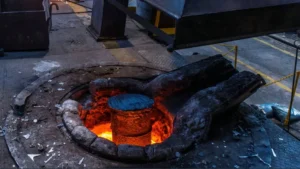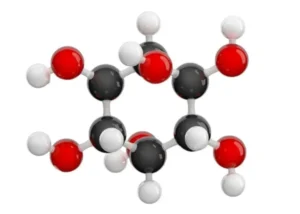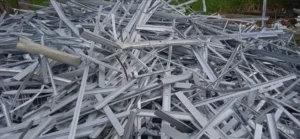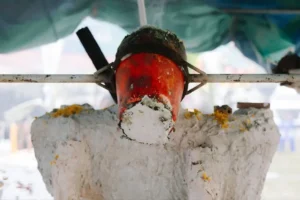The impact of automatic feeding systems (especially vibratory and electromagnetic types) on melting efficiency is significant and multifaceted. Compared to traditional manual feeding, automatic systems fundamentally optimize the operating conditions of the melting furnace by achieving a continuous, ইউনিফর্ম, and controllable feeding process. This leads to comprehensive improvements in thermal efficiency, melting speed, safety, এবং পরিবেশগত সুরক্ষা.
Below is a detailed comparison of manual versus automatic continuous feeding and an analysis of how automatic feeding systems achieve these optimizations:
Manual Feeding vs. Automatic Continuous Feeding: A Comparison
| Aspect | Manual Feeding (Intermittent) | Automatic Feeding System (Continuous) |
| Feeding Method | Batch, intermittent. Workers must open a large furnace door to charge an entire batch of cold (or insufficiently preheated) material at once or in several large dumps. | Continuous, small-batch, ইউনিফর্ম. Material is stably fed into the molten pool at a set rate via vibratory or electromagnetic drive. |
| Molten Pool State | Violent fluctuations. The sudden impact of large, cold materials causes a drastic drop in the molten pool’s level and temperature, leading to intense agitation and splashing. | Highly stable. Material is added uniformly, keeping the molten pool level constant and temperature fluctuations minimal. The melting process is smooth. |
| Heat Loss | Massive. Frequent opening of the large furnace door leads to “immense heat radiation loss.” The furnace’s thermal equilibrium is repeatedly broken, requiring extra energy to restore temperature. | Minimal. Typically paired with small or even sealed charging ports. The furnace door remains closed or is opened for extremely short periods, minimizing heat loss. |
| গলিত গতি | Slow and uneven. Cold material requires a long time to heat back up to its melting point (দ্য “heat absorption period”) after being charged, resulting in a long overall melting cycle. | Fast and efficient. The molten pool is always kept at a high temperature. Small batches of material melt quickly upon entry, achieving “melt-as-you-go” and significantly shortening the cycle. |
| Smoke & Splash | Severe. Manual charging, especially with damp or heavy materials, causes “molten metal splash” and generates “large amounts of smoke and dust,” polluting the environment and creating safety hazards. | Minimal. The continuous, uniform feeding method “effectively suppresses smoke and dust” and splashing. Vibratory feeders are proven to achieve “low-dust charging.” |
| শক্তি খরচ | উচ্চ. Large heat losses, long melting cycles, and low thermal efficiency lead to significantly higher specific energy consumption (যেমন, kWh/টন). | কম. Minimal heat loss and high thermal efficiency. Data shows that automation of feeding and level control alone can save 4% প্রতি 10% of energy. |
| নিরাপত্তা & Labor | Dangerous and labor-intensive. Workers must be in close proximity to the high-temperature furnace opening, facing risks from heat radiation, splashing, and toxic fumes. | Safe and labor-saving. Workers operate remotely, “without direct exposure to the furnace,” eliminating safety hazards and drastically reducing labor intensity. |
Core Impact Analysis of Automatic Feeding Systems on Melting Efficiency
Automatic feeding systems (vibratory/electromagnetic) are key to achieving a “continuous melting” process. Their efficiency improvements are primarily demonstrated in the following areas:
1.Maintaining Stable Molten Pool Level and Temperature
Manual feeding is a “batch” process; automatic feeding is a “continuous” process.
- Manual Feeding: A large volume of cold material added at once instantly absorbs a huge amount of heat from the molten pool, causing the melt temperature to “plummet.” একই সাথে, the impact of heavy materials on the liquid surface induces violent fluctuations and splashing.
- Automatic Feeding: A vibratory or electromagnetic feeder delivers material “like a steady stream” into the molten pool at a precisely controlled rate (যেমন, kg/minute). A dynamic equilibrium is achieved between the furnace’s heat input (যেমন, electric heating) and the material’s cold input (heat absorption). The molten pool is consistently maintained at a near-constant high temperature and a stable level, which is critical for a steady melting rate and metal quality.
2.Drastically Reducing Heat Loss and Improving Thermal Efficiency
A furnace’s heat loss primarily comes from the furnace body and radiation from openings.
- Manual Feeding: Requires frequent and prolonged opening of large-sized furnace doors or lids. The high-temperature furnace interior is directly exposed to the ambient air, causing massive heat radiation loss.
- Automatic Feeding: The charging port can be designed to be very small and can even be quasi-sealed by interfacing directly with the feeder (যেমন, the end of a vibratory chute). Material enters continuously through this small opening, eliminating the need to open the main furnace door. Studies show that compared to open-door charging, this continuous top-charge or side-charge method results in “virtually zero charging losses,” allowing energy to be used more effectively for melting metal and significantly increasing thermal efficiency.
3.Increasing Melting Speed and Equipment Utilization
Stable high temperatures and a continuous supply of material translate directly into a faster melting rate.
- Manual Feeding: The melting process is a cycle of “melt – wait – charge – reheat – melt.” দ্য “wait” এবং “reheat” phases constitute a significant amount of non-productive time.
- Automatic Feeding: The furnace remains in a “গলে যাওয়া” state at full power, eliminating the waiting and reheating periods. এই “maximizes furnace utilization,” leading to a significantly higher metal output per unit of time (kg/hour) compared to intermittent manual feeding. আরও, the uniform feeding avoids the physical impact of heavy charges on the furnace lining, reducing downtime for refractory repairs.
4.Significantly Reducing Smoke, Dust, and Splash
This is one of the most visible benefits of automatic feeding.
- Manual Feeding: When materials (especially scrap containing moisture or oil) are violently dropped into the high-temperature molten pool, the moisture instantly vaporizes and expands, causing micro-“explosions” that result in molten metal splash. একই সময়ে, contaminants on the material’s surface and metal oxides form large clouds of smoke and dust, which escape from the open furnace door.
- Automatic Feeding: Material gently slides or vibrates into the molten pool without causing a violent impact. Because the charging port is small and controllable, and can be paired with seals and dust collection systems, it “effectively suppresses” the escape of smoke and dust. This not only dramatically improves the workshop environment but, more importantly, eliminates the safety hazard of burns caused by splashing.







